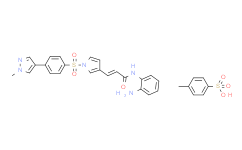| Cas No.: | 1186222-89-8 |
| Chemical Name: | (E)-N-(2-aminophenyl)-3-(1-((4-(1-methyl-1H-pyrazol-4-yl)phenyl)sulfonyl)-1H-pyrrol-3-yl)acrylamide |
| Synonyms: | 4SC-202;4SC 202;Domatinostat tosylate;Domatinostat;(E)-N-(2-aminophenyl)-3-(1-((4-(1-methyl-1H-pyrazol-4-yl)phenyl)sulfonyl)-1H-pyrrol-3-yl)acrylamide;264ARM7UXX;4SC202;(E)-N-(2-aminophenyl)-3-[1-[4-(1-methylpyrazol-4-yl)phenyl]sulfonylpyrrol-3-yl]prop-2-enamide;BCP18522;BDBM50470579;s7555;DB13101;SB16852;4SC 202 free base;4SC202 free base |
| SMILES: | S(C1C([H])=C([H])C(C2C([H])=NN(C([H])([H])[H])C=2[H])=C([H])C=1[H])(N1C([H])=C([H])C(/C(/[H])=C(\[H])/C(N([H])C2=C([H])C([H])=C([H])C([H])=C2N([H])[H])=O)=C1[H])(=O)=O |
| Formula: | C23H21N5O3S |
| M.Wt: | 447.5095 |
| Purity: | >98% |
| Sotrage: | 2 years -20°C Powder, 2 weeks 4°C in DMSO, 6 months -80°C in DMSO |
| Description: | Domatinostat tosylate (4SC-202) is a selective class I HDAC inhibitor with IC50 of 1.20 μM, 1.12 μM, and 0.57 μM for HDAC1, HDAC2, and HDAC3, respectively. It also displays inhibitory activity against Lysine specific demethylase 1 (LSD1). |
| In Vivo: | Oral gavage of Domatinostat tosylate inhibits HT-29 xenograft growth in nude mice, and when combined with oxaliplatin, its activity is further strengthened[2]. |
| In Vitro: | Domatinostat tosylate significantly reduces proliferation of all epithelial and mesenchymal UC cell lines (IC50 0.15-0.51 μM), inhibits clonogenic growth and induces caspase activity[1]. Domatinostat tosylate provokes apoptosis activation in CRC cells, while caspase inhibitors (z-VAD-CHO and z-DVED-CHO) significantly alleviate Domatinostat tosylate-exerted cytotoxicity in CRC cells. Meanwhile, Domatinostat tosylate induces dramatic G2-M arrest in CRC cells. Further studies show that AKT activation might be an important resistance factor of Domatinostat tosylate. Domatinostat tosylate-induced cytotoxicity is dramatically potentiated with serum starvation, AKT inhibition (by perifosine or MK-2206), or AKT1-shRNA knockdown in CRC cells. On the other hand, exogenous expression of constitutively active AKT1 (CA-AKT1) decreases the sensitivity by Domatinostat tosylate in HT-29 cells. Notably, Domatinostat tosylate, at a low concentration, enhances oxaliplatin-induced in vitro anti-CRC activity[2]. Domatinostat tosylate treatment induces potent cytotoxic and proliferation-inhibitory activities against established HCC cell lines (HepG2, HepB3, SMMC-7721) and patient-derived primary HCC cells. Domatinostat tosylate induces apoptosis signal-regulating kinase 1 (ASK1) activation, causing it translocation to mitochondria and physical association with Cyp-D[3]. |
| References: | [1]. Pinkerneil M, et al. Evaluation of the Therapeutic Potential of the Novel Isotype Specific HDAC Inhibitor 4SC-202 in Urothelial Carcinoma Cell Lines. Target Oncol. 2016 Dec;11(6):783-798. [2]. Zhijun H, et al. Pre-clinical characterization of 4SC-202, a novel class I HDAC inhibitor, against colorectal cancer cells. Tumour Biol. 2016 Aug;37(8):10257-67. [3]. Fu M, et al. 4SC-202 activates ASK1-dependent mitochondrial apoptosis pathway to inhibit hepatocellular carcinoma cells. Biochem Biophys Res Commun. 2016 Mar 4;471(2):267-73 [4]. S.W.Henning, et al. Preclinical characterization of 4SC-202, a noval isotype specific HDAC inhibitor. |

 To enhance service speed and avoid tariff delays, we've opened a US warehouse. All US orders ship directly from our US facility.
To enhance service speed and avoid tariff delays, we've opened a US warehouse. All US orders ship directly from our US facility.




















